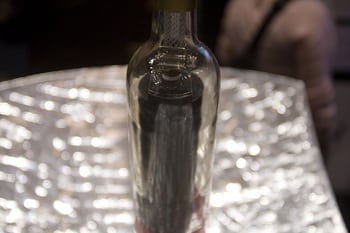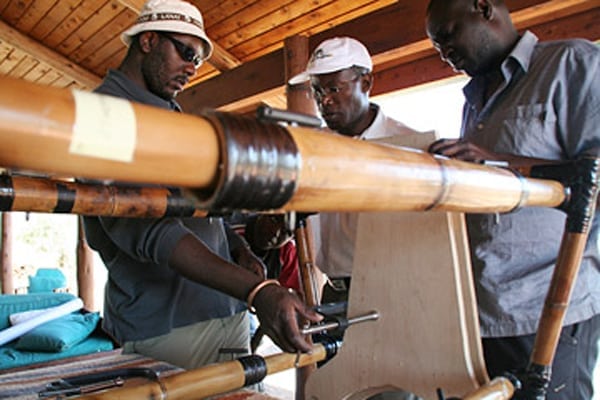This is a detail of the glass water bottle at the top of a solarclave prototype. Credit: Rob Goodier
Update: May 9, 2011 – Scissors, tweezers, scalpels and other medical instruments used for routine treatments must be heated and pressurized to kill microbes before reuse. This presents a real challenge to doctors and nurses at health posts in rural Nicaragua because sterilization takes more than boiling water. Instead, they must beautoclaved using high-pressure steam at 121 degrees C or higher for 15 to 20 minutes. Since autoclaves are rare in rural settlements, that means sending everything back to a central clinic for sterilization.
To save the time spent hauling instruments to and from those hard-to-reach posts, Anna Young and other MIT engineers are developing a “solarclave.” Their design can work in off-grid clinics, it’s cheap, relatively simple to repair, and it can save lives. In recognition of the device’s potential, the team won $7500 to help develop the design at MIT’s Global Challenge in May, 2011.
How it works
The prototype is built from a modified satellite TV dish, a wine bottle, and a pressure cooker. The dish is covered in tin foil and the wine bottle is filled with water, sealed, and suspended on the rod above the center of the dish to form a solar water boiler. The sun heat the water and pushes steam into the pressure cooker through a pipe at the top of the bottle.
In tests, the solarclave reaches operating temperatures in an hour. It can then sterilize medical instruments at 121 C and 15 psi for 20 minutes. That is the temperature, pressure and durationrecommended by the US Centers for Disease control and Prevention.
“It may not be better than an electric autoclave, but it’s not worse,” Young told E4C.
Solarclave prototypes handled well in field tests last year. Credit: Vincent Ted Liao
Cheap and off the grid
In fact, the solarclave may be better for small clinics. Autoclaves are expensive – even a small desktop model can cost nearly $2000 – and they can break down with little chance for repair. When Young visited one clinic near Ocotal, a town in northern Nicaragua, she saw nurses using a broken autoclave as a purse locker. The machines also require electricity, which can be a deal breaker for some of the off-grid health posts.
Saved by autoclaves
About 3 billion people in the world rely on rural clinics in developing countries for their primary care. In those regions, 5 to19 percent of hospitalized patients get an infection at the hospital sometime during their stay, the World Health Organization reports. In comparison, 4.5 percent of US hospital patients are infected during treatment.
Sterile medical instruments can prevent are some of the most common infections in developing countries. One to nearly 25% of hospital infections are in wounds or surgical incisions, WHO reports. And neonatal infections are three to 20 times higher in developing countries than in the West. In part for those reasons, WHO recognized the solarclave as an innovative health technology.
What’s next
Young and the MIT engineers plan to take solarclave prototypes to Nicaragua in January. They’re looking for clinics with nearby sunny spots and staff with an interest in the technology. Neither should be hard, Young said: It’s a tropical country, after all, and she noticed that gadget curiosity was as thriving there as it is up north.
Resources
From E4C’s Solutions Library: The Solarclave
For more information, please see MIT’s Innovations in International Health site.
Explanatory poster for WHO
Poster for USAID
Credit: Vincent Ted Liao




